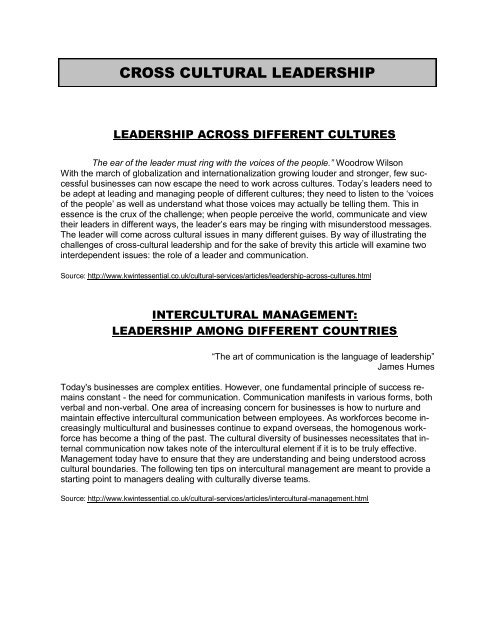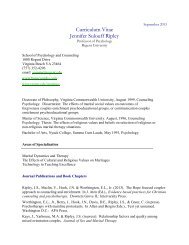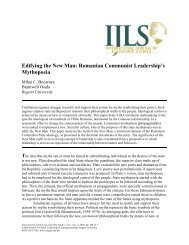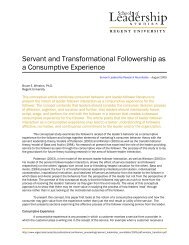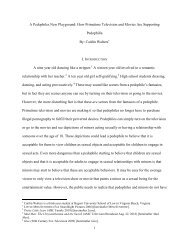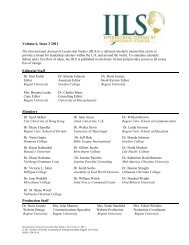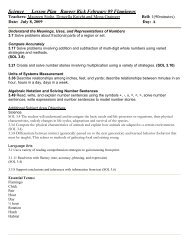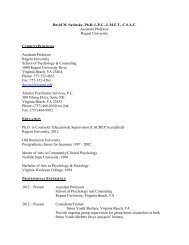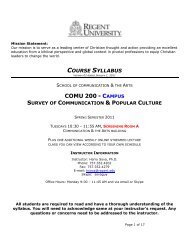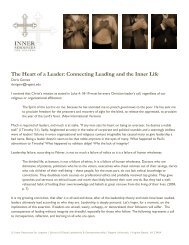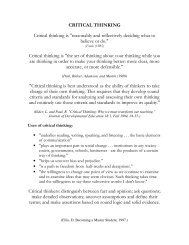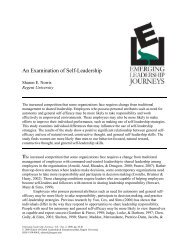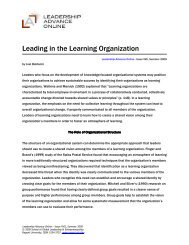CROSS CULTURAL LEADERSHIP
CROSS CULTURAL LEADERSHIP
CROSS CULTURAL LEADERSHIP
Create successful ePaper yourself
Turn your PDF publications into a flip-book with our unique Google optimized e-Paper software.
<strong>CROSS</strong> <strong>CULTURAL</strong> <strong>LEADERSHIP</strong><br />
<strong>LEADERSHIP</strong> A<strong>CROSS</strong> DIFFERENT CULTURES<br />
The ear of the leader must ring with the voices of the people.” Woodrow Wilson<br />
With the march of globalization and internationalization growing louder and stronger, few successful<br />
businesses can now escape the need to work across cultures. Today‟s leaders need to<br />
be adept at leading and managing people of different cultures; they need to listen to the „voices<br />
of the people‟ as well as understand what those voices may actually be telling them. This in<br />
essence is the crux of the challenge; when people perceive the world, communicate and view<br />
their leaders in different ways, the leader‟s ears may be ringing with misunderstood messages.<br />
The leader will come across cultural issues in many different guises. By way of illustrating the<br />
challenges of cross-cultural leadership and for the sake of brevity this article will examine two<br />
interdependent issues: the role of a leader and communication.<br />
Source: http://www.kwintessential.co.uk/cultural-services/articles/leadership-across-cultures.html<br />
INTER<strong>CULTURAL</strong> MANAGEMENT:<br />
<strong>LEADERSHIP</strong> AMONG DIFFERENT COUNTRIES<br />
“The art of communication is the language of leadership”<br />
James Humes<br />
Today's businesses are complex entities. However, one fundamental principle of success remains<br />
constant - the need for communication. Communication manifests in various forms, both<br />
verbal and non-verbal. One area of increasing concern for businesses is how to nurture and<br />
maintain effective intercultural communication between employees. As workforces become increasingly<br />
multicultural and businesses continue to expand overseas, the homogenous workforce<br />
has become a thing of the past. The cultural diversity of businesses necessitates that internal<br />
communication now takes note of the intercultural element if it is to be truly effective.<br />
Management today have to ensure that they are understanding and being understood across<br />
cultural boundaries. The following ten tips on intercultural management are meant to provide a<br />
starting point to managers dealing with culturally diverse teams.<br />
Source: http://www.kwintessential.co.uk/cultural-services/articles/intercultural-management.html
BUSINESS ETIQUETTE<br />
BUSINESS CARD ETIQUETTE<br />
When doing business abroad it is important to understand the local culture. Culture includes<br />
areas such as a country's norms, values, behaviours, food, architecture, fashion and art. However,<br />
one area of culture that is important for the international business person is etiquette. Understanding<br />
business etiquette allows you to feel comfortable in your dealings with foreign<br />
friends, colleagues, customers or clients. Knowing what to do and say in the right places will<br />
help build trust and open lines of communication. One aspect of etiquette that is of great importance<br />
internationally is the exchanging of business cards. Unlike in North America or<br />
Europe where the business card has little meaning other than a convenient form of capturing<br />
essential personal details, in other parts of the world the business card has very different<br />
meanings.<br />
Source : http://www.kwintessential.co.uk/cultural-services/articles/business-card-etiquette.html<br />
BUSINESS LUNCH ETIQUETTE<br />
Business lunches are very common in many countries and cultures. Food itself is one of the most visible<br />
manifestations of a culture and is something people are proud of and like to share with guests to their<br />
country. However, just as the food changes from culture to culture so does the intention and etiquette<br />
surrounding the lunch. In some cultures the business lunch is a time for chit-chat and building relationships,<br />
in others simply a fuel stop at which people continue to talk about business, known as the<br />
"working lunch". For the international globe-trotter it is always beneficial to have an appreciation and<br />
understanding of a local culture and any etiquette or protocol.<br />
Source: http://www.kwintessential.co.uk/cultural-services/articles/business-lunch.html<br />
FURTHER RESOURCES<br />
Doing business in...Etiquette and Protocols:<br />
http://www.kwintessential.co.uk/etiquette/doing-business-in.html<br />
Businesses in different cultures:<br />
http://www.kwintessential.co.uk/cultural-services/articles-business.html
UNDERSTANDING MAJOR DIFFERENCES IN<br />
<strong>CROSS</strong>-<strong>CULTURAL</strong> COMMUNICATION<br />
“…the single greatest barrier to business success is the one erected by culture."<br />
Edward T. Hall and Mildred Reed Hall<br />
Source: http://www.kwintessential.co.uk/cross-cultural/cross-cultural-awareness.html<br />
<strong>CROSS</strong> <strong>CULTURAL</strong> BUSINESS BLUNDERS<br />
These are some examples of how cultural ignorance can and does lead to negative (and much<br />
of the time humorous) consequences. The following cultural blunders are presented in order<br />
illustrate to people how crucial cultural awareness is in international business today.<br />
1. Managers at one American company were startled when they discovered that the brand<br />
name of the cooking oil they were marketing in a Latin American country translated into<br />
Spanish as "Jackass Oil."<br />
2. American Motors tried to market its new car, the Matador, based on the image of courage<br />
and strength. However, in Puerto Rico the name means "killer" and was not popular on the<br />
hazardous roads in the country.<br />
3. A US telephone company tried to market its products and services to Latinos by showing a<br />
commercial in which a Latino wife tells her husband to call a friend, telling her they would<br />
be late for dinner. The commercial bombed since Latino women do not order their husbands<br />
around and their use of time would not require a call about lateness.<br />
4. A cologne for men pictured a pastoral scene with a man and his dog. It failed in Islamic<br />
countries dogs are considered unclean.<br />
5. Proctor & Gamble used a television commercial in Japan that was popular in Europe. The<br />
ad showed a woman bathing, her husband entering the bathroom and touching her. The<br />
Japanese considered this ad an invasion of privacy, inappropriate behavior, and in very<br />
poor taste.<br />
6. An American business person refused an offer of a cup of coffee from a Saudi businessman.<br />
Such a rejection is considered very rude and the business negotiations became<br />
stalled.<br />
7. A Japanese manager in an American company was told to give critical feedback to a subordinate<br />
during a performance evaluation. Japanese use high context language and are<br />
uncomfortable giving direct feedback. It took the manager five tries before he could be direct<br />
enough to discuss the poor performance so that the American understood.<br />
8. One company printed the "OK" finger sign on each page of its catalogue. In many parts of<br />
Latin America that is considered an obscene gesture. Six months of work were lost because<br />
they had to reprint all the catalogues.
HIGH CONTEXT VS. LOW CONTEXT COMMUNICATION<br />
First used by author Edward Hall, the expressions "high context" and "low context" are labels<br />
denoting inherent cultural differences between societies. High-context and low-context communication<br />
refers to how much speakers rely on things other than words to convey meaning. Hall<br />
states that in communication, individuals face many more sensory cues than they are able to<br />
fully process. In each culture, members have been supplied with specific "filters" that allow<br />
them to focus only on what society has deemed important. In general, cultures that favor lowcontext<br />
communication will pay more attention to the literal meanings of words than to the context<br />
surrounding them.<br />
Source: http://hubpages.com/hub/High-Context-vs-Low-Context-Communication<br />
INDIVIDUALISTIC VS. COLLECTIVISTIC CULTURES<br />
There are two contrasting cultural orientations: one values individualism, and<br />
the other values collectivism. In a worldwide study of 116,000 employees of IBM,<br />
Geert Hofstede (1980) found that the most fiercely independent people were from<br />
the US, Australia, Great Britain, Canada, and the Netherlands, in that order. In<br />
contrast, the most interdependent people were from Venezuela, Colombia, Pakistan,<br />
Peru, and Taiwan.<br />
Source: http://www.cranepsych.com/Psych/Individual_Collectivist.pdf<br />
Hofstede’s Intercultural dimensions<br />
An article helping to understand the factors that differentiate cultures<br />
Professor Hofstede's four dimensions are:<br />
Power Distance<br />
This dimension relates to the degree of equality/inequality between people in a particular society.<br />
A country with a high Power Distance score both accepts and perpetuates inequalities between<br />
people. An example of such a society would be one that follows a caste system and in<br />
which upward mobility is very limited.<br />
A low Power Distance indicates that a society does not emphasize differences in people's<br />
status, power or wealth. Equality is seen as the collective aim of society and upward mobility is<br />
common.<br />
Read more on Power Distance or Have a look at the world map of power distance scores.<br />
Individualism<br />
This dimension focuses on the degree to which a society reinforces individual or collective<br />
achievement and interpersonal relationships.<br />
If a country has a high Individualism score, this indicates that individuality and individual rights<br />
are dominant. Individuals in these societies tend to form relationships with larger numbers of<br />
people, but with the relationships being weak.<br />
A low Individualism score points to a society that is more collectivist in nature. In such countries<br />
the ties between individuals are very strong and the family is given much more weight. In<br />
such societies members lean towards collective responsibility.<br />
Read more on Individualism or Have a look at the world map of individualism scores.
Uncertainty Avoidance<br />
This dimension concerns the level of acceptance for uncertainty and ambiguity within a<br />
society. A country with a high Uncertainty Avoidance score will have a low tolerance towards<br />
uncertainty and ambiguity. As a result it is usually a very rule-orientated society and follows<br />
well defined and established laws, regulations and controls.<br />
A low Uncertainty Avoidance score points to a society that is less concerned about ambiguity<br />
and uncertainty and has more tolerance towards variety and experimentation. Such a society<br />
is less rule-orientated, readily accepts change and is willing to take risks.<br />
Read more on Uncertainty Avoidance or Have a look at the world map of uncertainty avoidance<br />
scores.<br />
Masculinity<br />
This dimension pertains to the degree societies reinforce, or do not reinforce, the traditional<br />
masculine work role model of male achievement, control, and power.<br />
A high Masculinity score indicates that a country experiences a higher degree of gender differentiation.<br />
In such cultures, males tend to dominate a significant portion of the society and<br />
power structure. A low Masculinity score means a society has a lower level of differentiation<br />
and inequity between genders. In these cultures, females are treated equally to males in all<br />
aspects of the society.<br />
Read more on Masculinity or Have a look at the world map of masculinity scores.<br />
An Application of the Intercultural Scores - The UK<br />
By way of illustrating how the scores work the example of the UK shall be examined.<br />
First think about what you know or understand about British society and culture and then try<br />
and gage what the scores may be? Would the UK have a high or low Power Distance? Is it a<br />
very individualistic society? Are they a people that entertain risks? Is it a very gender orientated<br />
society? Try and think of the scores you would give to the UK for each dimension (scores<br />
range between 0 and 100).<br />
Power Distance: The UK's score in this dimension is 35. This indicates that rank, status and<br />
inequalities between people are reasonably low. On a macro level this manifests in a number<br />
of ways, such as legislation protecting ethnic minorities? rights. On a micro level this is witnessed<br />
in the office where the relationship between superiors and subordinates is relatively<br />
casual and incorporates little ceremony.<br />
Individualism: The UK scores 89 for Individualism. This is high and therefore points to that<br />
fact that British culture values and promotes individuality. On a macro level we see that the nuclear<br />
family is the more predominant form of basic social structure. On a micro level, in the<br />
business environment the individual may be more concerned with themselves rather than the<br />
team.<br />
Uncertainty Avoidance: For this dimension the UK scores 35 which is quite low. This means<br />
British culture is relatively open to taking risks and dealing with change. On a macro level this<br />
can be seen in the constant revision of laws and government structures. On a micro level, conflict<br />
or disagreement in the workplace, even with superiors, is considered healthy.<br />
Masculinity: The UK scores 66 which indicates that it is somewhere in the middle. This may<br />
reflect the fact that British society and culture aims for equality between the sexes, yet a certain<br />
amount of gender bias still exists underneath the surface.<br />
1) If you are playing the Intercutural Awareness game you can now proceed to read the Intercultural<br />
Awareness Rules or go straight to the Intercultural Awareness game.<br />
2) If you are using the graph tool please go back to Intercultural Business Communication.<br />
Source: http://www.kwintessential.co.uk/intercultural/dimensions.html
Cultural Etiquette:<br />
http://www.kwintessential.co.uk/<br />
http://www.cyborlink.com/<br />
http://www.culturecrossing.net/<br />
FURTHER INFORMATION<br />
Travel section:<br />
http://www.homefair.com/articles/adapting-to-foreign-country.asp?cc=1<br />
Getting adapted to the new environment:<br />
http://www.newcomersclub.com/<br />
Intercultural communication:<br />
http://www.diplomacy.edu/Language/Communication/default.htm<br />
Multicultural issues - Videos:<br />
http://www.kwintessential.co.uk/intercultural/diversity-videos.html<br />
Guide to country profiles:<br />
http://www.kwintessential.co.uk/resources/country-profiles.html
<strong>CROSS</strong> <strong>CULTURAL</strong> WORKPLACE<br />
RELIGION, CULTURE AND WORKPLACE<br />
Many religions carry dress codes or guidelines on appearance and presentation.<br />
Khalsa Sikhs wear five religious symbols known as the five K's. Two are not visible, but the<br />
'Kara' (a steel bangle worn on the wrist) and the 'Kesh' (uncut hair usually underneath a turban)<br />
are worn on the outside. The 'Kirpan' (a decorative sword) does not necessarily have to<br />
be visible. Muslim women are required to cover their bodies as a sign of modesty. Interpretations<br />
of the Quran differ so you may see Muslim women wearing just a head covering whereas<br />
others may only show their eyes. Muslim men on the whole do not have specific restrictions on<br />
their dress although they are strongly encouraged to wear a beard. Again, interpretations as to<br />
what constitutes a beard vary…<br />
Source: http://www.kwintessential.co.uk/cultural-services/articles/religion-belief-hr-2.html<br />
Source: http://www.kwintessential.co.uk/cultural-services/articles/religion-belief-hr-3.html<br />
CULTURE IN GLOBAL TEAMS<br />
The homogenous team is a thing of the past in most international organizations and companies.<br />
More and more teams are made up of people with different nationalities and therefore<br />
different cultures, languages, ideas, behaviors and ways of doing things. Some would argue<br />
that the ‘international language of business’ negates any communication issues within such a<br />
cross-cultural team; however those with hands-on experience of such teams would disagree.<br />
When people of different cultural backgrounds come together in any setting there will always<br />
be issues in terms of interaction. This is because they bring with them their own cultural baggage<br />
in terms of how they do things and expect things to be done. Cross-cultural issues will<br />
not always be a hindrance, in fact they can many a time be a force for positive creativity, but as<br />
and when a clash of cultures occur it has a negative impact, especially within a team…<br />
Source: http://www.kwintessential.co.uk/cultural-services/articles/culture-global-teams.html<br />
<strong>CROSS</strong> <strong>CULTURAL</strong> INTERVIEWS<br />
At this moment in time, the increase in cross border human traffic has meant that companies<br />
are no longer dealing with a homogenous native community from which they recruit their<br />
staff. Companies are now facing cross cultural challenges in how they recruit, manage and<br />
develop a multi-cultural staff. One area of note where HR and management are finding difficulties<br />
is in the interview room. With companies recruiting from a pool of candidates from different<br />
nationalities, cultures and faiths the cross cultural interview is an area that must be analyzed<br />
properly if recruiters wish to capitalize on the potential available to them. This is necessary to<br />
ensure that candidates in cross cultural interviews are not discriminated against through misperceptions<br />
and poor judgments…<br />
Source:http://www.kwintessential.co.uk/cultural-services/articles/cross-cultural-interviews.html
STAGES OF CULTURE SHOCK<br />
'Culture shock' is used to describe the emotional rollercoaster that someone experiences<br />
when living in a new country. Anyone that has worked and lived in a foreign country will<br />
experience culture shock of some sort. Culture shock affects anyone from business personnel<br />
and their families, to EFL teachers to sports stars. Recognizing culture shock is an important<br />
way of being able to deal with it. Dealing with it helps minimize the risk of becoming disillusioned<br />
with a new country and the possibility of deciding that a quick return 'home' is the only<br />
solution. Experts agree that culture shock has stages and all agree that once people get beyond<br />
the initial and most difficult stages, life in a new country becomes a lot better.<br />
Outlined below is an example of the stages people go through with culture shock:<br />
Stage 1 - Excitement<br />
The individual experiences a holiday or 'honeymoon' period with their new surroundings.<br />
They:<br />
Feel very positive about the culture<br />
Are overwhelmed with impressions<br />
Find the new culture exotic and are fascinated<br />
Are passive, meaning they have little experience of the culture<br />
Stage 2 - Withdrawal<br />
The individual now has some more face to face experience of the culture and starts to find<br />
things different, strange and frustrating.<br />
They:<br />
Find the behavior of the people unusual and unpredictable<br />
Begin to dislike the culture and react negatively to the behavior<br />
Feel anxious<br />
Start to withdraw<br />
Begin to criticize, mock or show animosity to the people<br />
Stage 3 - Adjustment<br />
The individual now has a routine, feels more settled and is more confident in dealing with the<br />
new culture.<br />
They:<br />
Understand and accept the behavior of the people<br />
Feel less isolated<br />
Regains their sense of humor<br />
Stage 4 - Enthusiasm<br />
The individual now feels 'at home'.<br />
They:<br />
Enjoy being in the culture<br />
Functions well in the culture<br />
Prefer certain cultural traits of the new culture rather than their own<br />
Adopt certain behaviors from the new culture<br />
© Kwintessential Ltd<br />
Source: http://www.kwintessential.co.uk/cultural-services/articles/cultureshock-stages.html
A Glance at Asian &<br />
Singapore Culture &<br />
Etiquette<br />
Presented by<br />
Timothy Lim<br />
29 January 2009
Define Asia<br />
Contents<br />
Disclaimer for this Presentation<br />
Statistics on Singapore<br />
Culture Shock?<br />
Awkward Cultural Mistake?<br />
Basic Social Etiquette<br />
Basic Business Etiquette<br />
Concluding Remarks
Central Asia:<br />
Define Asia<br />
Monogolia; Russia, Kazakhstan; Kyrgyzstan; Tajikistan; Turkmenistan; Uzbekistan<br />
South Asia:<br />
The Subcontinent of South Asia; India; Pakistan; Nepal<br />
Northeast Asia<br />
China (and including Hong Kong); Taiwan; North Korea; South<br />
Korea; Japan; Taiwan<br />
Southeast Asia:<br />
Bangladesh; Bhutan; Brunei; Cambodia; Laos; China;<br />
Indonesia; Laos; Malaysia; Maldives; Myanmar; Papa new<br />
Guinea‟ Philippines; Singapore; Sri Lanka; Thailand; Vietnam
Map of Asia
Singapore, a part of Southeast Asia
Asia at a Glance<br />
3 Largest Nation: Russia, China, & India<br />
Former Communist State: Russia, China, Vietnam,<br />
Cambodia, Burma/Myanmar<br />
Current Communist Nations: China<br />
Christianized Nation: Philippines (R.C.)<br />
Islamic Nations: Malaysia; Indonesia<br />
Buddhist Nations: Thailand, Burma, Japan, Nepal,<br />
Sri Lanka<br />
Confucianist Nation: Taiwan (debatable)<br />
Strong Chinese Religious Representation in<br />
these Nations: Thailand, Taiwan, Hong Kong,<br />
Malaysia, South Korea, Singapore<br />
Others: India (Strong Hindu, and Buddhist influence)
The Lion City of Singapore<br />
The Story of “Singapura”
The Singapore Skyline at the Central<br />
Business District Area<br />
A Clean and Green City – A “Fine” Society
National Statistics & Data<br />
(June 2008)<br />
Total Population:<br />
4.839 millions, of which are<br />
3.642 millions Singapore<br />
Citizens & PR.<br />
National Flower: Vanda Ms<br />
Joachim<br />
Land Area: 682 sq. km.<br />
Temperature: 73 - 88FH<br />
Population:<br />
75% Chinese; 13.7% Malays;<br />
8.7% Indians; 2.6% others.
Language & Education<br />
Official Language: Malay<br />
Business / Administration / Educational<br />
Language: English<br />
Literary Rate: 94.2%<br />
Of which, 56.7% has Secondary Education &<br />
above (from @15 onwards)<br />
Reputable international standing for its<br />
Tertiary Educational Institutions
Religions in Singapore –at a glance<br />
Buddhism 42.5 %<br />
Chinese Religions 8.5 %<br />
Christianity 14.6 %<br />
Hinduism 4.0 %<br />
Islam 14.9 %<br />
No Religions 14.8 %<br />
Others 0.6 %
Snapshots of Some Chinese Customs<br />
and Festivals<br />
Chinese Lunar New Year<br />
The worship of the „Monkey<br />
God‟<br />
Hungry Ghost Festival
Buddhism in Singapore<br />
A Buddhist Temple in Singapore
A Buddhist Religious Event
A Buddhist Religious Event
A Buddhist Religious Event
Christianity at a glance
Sunday Worship Service with the<br />
Methodist Church in Singapore<br />
Paya Lebar Chinese Methodist Church<br />
Choir picture from another Methodist Church
A Mega-Youth Worship Service at<br />
City Harvest Church
A Mega-Youth Seminar organized<br />
by the City Harvest Church at The<br />
Singapore Indoors Stadium
Hinduism in Singapore<br />
Sri Mariamman Temple
Hinduism in Singapore<br />
The Thaipusam
Hinduism in Singapore<br />
Praying in the temple during<br />
the Deepavali festival<br />
Offering of the body during<br />
the Thaipusam festival
Hinduism in Singapore<br />
Thaipusam Preparation, a shot<br />
inside the Hindu Temple
Islam in Singapore<br />
The Sultan Mosque of<br />
Singapore
Islam in Singapore<br />
Visiting during Hari-Raya<br />
Malay Schools
Culture Shock???<br />
1. Bubble Gum Sales<br />
2. Singlish<br />
3. No Refills (of drinks) in fastfood<br />
outlets
Awkward „Cultural Mistake‟<br />
1. Face-value meaning in conversations?<br />
2. Wearing shoes in someone‟s home<br />
3. Homogenity of all races?<br />
4. Addressing acquaintances?<br />
5. Casual remarks on meeting up?<br />
6. Giving of hugs and kisses?
Basic Social Etiquette<br />
1. Appropriate & inappropriate gifts<br />
2. Reciprocation of gifts<br />
3. Opening gifts before giver(s)<br />
4. Social protocol on timing for events<br />
5. Chinese seating protocol for seat-down<br />
meals<br />
6. playing with your fingers
Business Etiquette<br />
1. Symbolism of Numbers<br />
2. Concept of Time<br />
3. Gifts<br />
4. Small Talks<br />
5. Malaysian Business 101<br />
6. Chinese Biz Relationships<br />
7. Chinese Negotiation Tools
Concluding Remarks<br />
1. Forgiving towards westerners?<br />
2. Air-Conditioned Society<br />
3. Efficiency, Effectiveness & Convenience<br />
4. Availability of Cosmopolitan food?<br />
5. Vibrant night life?<br />
6. Medical & Pre-scheduled appointments<br />
7. Brick houses / apartment?
Some Prayer Items<br />
1. That the materially blessed Christians in Singapore<br />
would hunger for more of God and walk with Him!<br />
2. That the Christians in Singapore will be FAITHFUL and<br />
CREATIVE witnesses in the midst of religious pluralism,<br />
and to operate wisely whilst complying with the Religious<br />
Harmony Act.<br />
3. That we will not become too comfortable with the<br />
peace and prosperity God has given to Singapore, but<br />
that we would be the salt and blazing light for Him,<br />
i.e., to take up our role as the “Antioch” people of global<br />
Christian missions, and be exemplary in our efforts to<br />
reach those from the different strata of our society,<br />
allowing them to experience God‟s love!
Conclusion<br />
Please Keep in Touch:<br />
Timothy Lim<br />
worldtim@hotmail.com<br />
1-757-401-7145 (Hp)<br />
Thanks & God Bless!
Comparative Cultural Etiquette<br />
Please give us your feedback.


